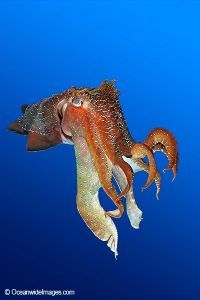GIANT CUTTLEFISH
|
| Type of dive: |
|
Animal interaction |
| Snorkelling: |
|
Yes, mesmerising! |
| Scuba: |
|
Open Water |
| Access: |
|
Shore |
| Depth: |
|
3 – 6 metres (10-20’) |
| Visibility: |
|
2 – 5 metres (7-16’) |
| Water temperature: |
|
12 – 22°C (54-72°F) |
| Seasonal: |
|
Yes, breeding season is May to August |
In winter every year, near Whyalla, the population of Australian giant cuttlefish explodes for their mating season.
In the Upper Spencer Gulf Marine Park, giant cuttlefish numbers peak in June and July when over 100,000 congregate in shallow waters off Point Lowly and Stony Point to spawn.
During the spawning season, snorkellers and scuba divers alike will be dazzled by spectacular underwater light shows, colour displays and antics designed to lure mates.
These mesmerising creatures are the masters of disguise capable of transforming themselves into the colour, texture and shape of the environment around them.
The Australian giant cuttlefish (Sepia apama) is native to Australia and can be found from southern Queensland all the way south, including Tasmania, to the west as far as Ningaloo Reef off Exmouth in the north of Western Australia.
Whilst natural predators of Australian giant cuttlefish include bottle-nosed dolphins, fur seals, and yellowtail kingfish, cuttlefish numbers declined significantly in the 1990’s due to over fishing by the commercial snapper fishing industry that used cuttlefish as bait.
Due to declining numbers, the Australian giant cuttlefish was listed as Near Threatened on the International Union for Conservation of Nature (IUCN) Red List of Threatened Species in 2009. As a result, commercial fishing pressures were reduced and numbers have now recovered to be in excess of 200,000!
Cuttlefish, octopus, squid and nautilus are all cephalopods, a Greek derived name meaning head foot, belonging to the phylum Mollusca, the second largest phylum of invertebrates.
All cephalopods are characterised by a large head, a minimum of eight, often modified tentacles, a siphon, two eyes and a mantle.
Their bodies are soft and all have three hearts, and pump blue blood due to the copper-based protein which transports oxygen around the body. Only nautiluses have an external shell.
Australian giant cuttlefish is the largest species of cuttlefish in the World and males can grow up to a metre (40”) in length and weigh up to 10 kilograms (22 lbs).
They have ten tentacles, eight arms and two modified feeding arms and use specialised cells, chromatophores, to instantly change their colour to match their background.
During the mating season, males usually outnumber females by around ten to one.
Mating occurs head-to-head and the male will pass a sperm package to the female who stores it under her mantle. Females will produce 100 – 1000 eggs (5 to 40 per day) which are fertilised by multiple males. Cuttlefish eggs are deposited under rocky ledges and take three to six months to hatch.
Cuttlefish live for only one to two years and die after only one mating cycle, once they have laid their eggs seeding the next generation.
The underwater display provided by these fascinating creatures is simply spectacular.
Special thanks to the Whyalla Diving Services team.
Copyright © 2024 Steve Sinclair
Other great Australian animal dives:
Exmouth Whale Sharks, Exmouth Humpback, Great White Sharks, Burrunan Dolphins, Montague Island Seals, Tollgate Islands Grey Nurse Sharks, Mantra Ray Bommie, Dwarf Minke Whales, Cod Hole, North Horn Shark Feed and Raine Island Turtles.
Local dive services:
|
|
WHYALLA DIVING SERVICES |
|
|
DIVING ADELAIDE |
Other services:
|
|
Need somewhere to eat, drink or stay? |
 |
BLAST EXPERIENCES |






OTHER INFORMATION
LOCATION
State or Territory:
South Australia
Nearest City:
Adelaide
Nearest Regional City:
Whyalla
Nearest Town:
Not relevant
HOW TO GET THERE
Air:
Nearest International Airport:
Adelaide
Nearest Domestic/Regional Airport:
Whyalla
Road:
Adelaide to Whyalla:
4 hr 30 min (385 km/240 mi) via National Highway A1
Bus:
From Adelaide
Train:
Not available
THINGS TO DO
Tour the Tuna Farms
Sample the local sea food
Deep Sea Fishing
Port Lincoln National Park Four Wheel Drive Tours
Wine Tours
Wildlife Parks
Kite Boarding
Paddle Boarding
Elvis Museum
Steelworks Tour





















